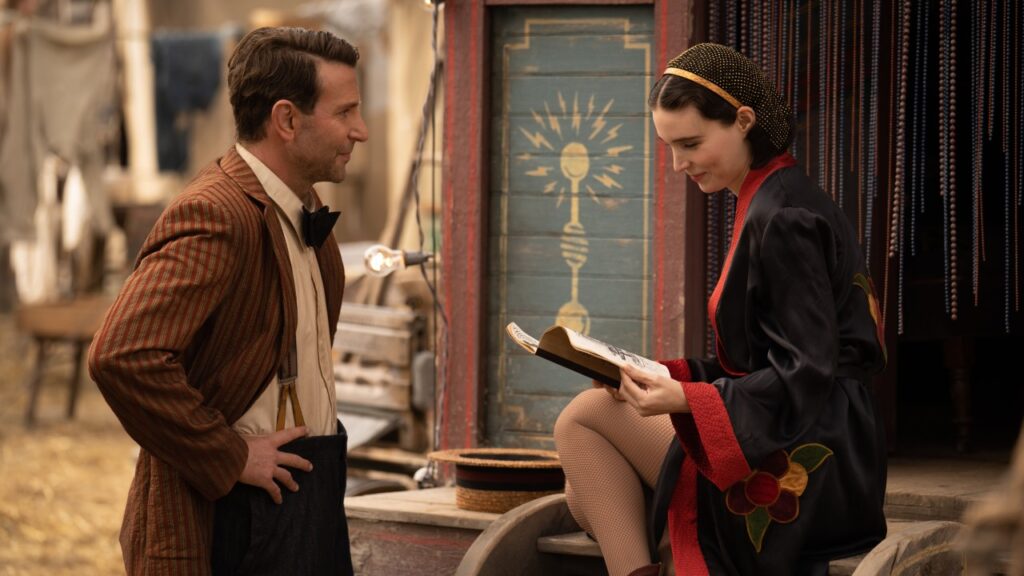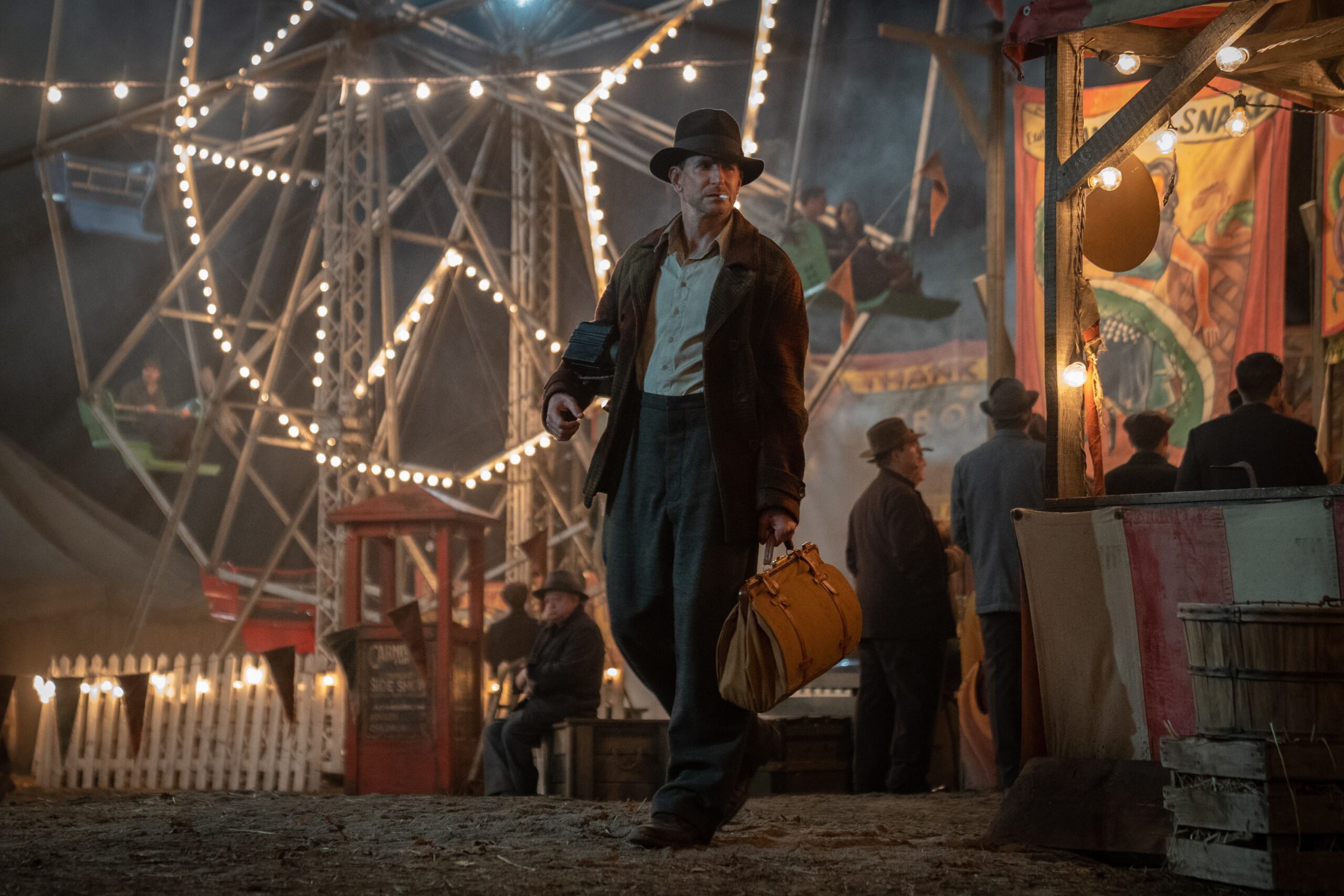Nightmare Alley Really is an Existential Nightmare. I wandered into this one completely blind during an unwitting date night where my wife and I were just blissfully following these enormous actors into the movie theater. Uh, yeah. What exactly did I just watch? Nightmare Alley is like nothing I’ve ever seen before. Maybe the best analogy is The Prestige? I don’t know, that doesn’t quite fit… but it does at the same time. You know, a period, historical piece, filled with magic and con-men determined to win. Yeah, The Prestige is a pretty good analogy here. Similarly, The Prestige stayed well inside the practical trickery of magic (remember, I don’t believe the cloning machine worked) and so did Nightmare Alley… and as we watched The Prestige show the consequences of absolute dedication to winning, so too do we see how horrible the consequences can be for individuals lost in their craft, and the hope and goal of winning at all other costs.
Without getting into spoilers – just yet – Nightmare Alley shows the audience a morality tale of epic consequences. A story about horrible people, doing horrible things to one another, and the consequences of said horribleness. But more so, it’s a story about evil. A story about how evil’s outcome is always more evil – and how you may not see it coming, but you’ll recognize it when it arrives.
Sin & Guilt Drive Nightmare Alley’s Momentum – Spoilers
In Guillermo del Toro’s version of the film – which is based on the novel of the same that came out in 1946. Pro-tip? There is another film adaptation of the book, and some would argue (including myself) that the original is actually better than del Toro’s version. It’s a tighter film, shorter, and way more concise. If you are interested, you can watch the original of Nightmare Alley on Youtube for free. Del Toro’s clocks in at two and a half hours. It’s so long, that the film actually feels like 2 different movies. The first movie being the carnies and the old-time carnival world. The second part being the big city tour of their show. And the only thing really connecting the two being the ending. In my opinion. But we’ll get to that in a minute.
Del Toro’s story tells of Stan, an evil man who has killed his father. We learn at the end of the movie that Stan (played by Bradley Cooper) always hated his father, and while he was taking care of him, he opens the window, and allows the man to freeze to death. And this? This is our over the top motivator of guilt for Stan that drives him the duration of the movie. Later, while learning the ropes at the traveling carnival, Stan intentionally gives Pete (played by David Strathairn) the wood alcohol that kills him, so that Stan can get his playbook of Carny mentalist tricks. Then later, after Stan and Molly (played by Rooney Mara) connect with a psychologist Dr. Lillith Ritter (played by Cate Blanchett). Stan abandons Molly in order to work with Ritter on a con to swindle hundreds of thousands of dollars from New York’s richest socialites. More guilt. And ultimately, when Stan realizes that Molly looks exactly like Ezra Grindle’s dead wife, he asks Molly for one last con. But when it goes all kinds of pear-shaped, Molly flees, and Stan ultimately winds up in the worst possible place imaginable. Back where he started.
Where del Toro Went All Wrong with Nightmare Alley
I’ve now watched del Toro’s version, the original 1947 version, and I’ve also read most of the book. And while all three are very similar, del Toro’s version completely lost the single thread that ran through the original book and movie. Guilt. Stan’s guilt, not to put too fine a point on it. In the original movie, we see how Stan was horribly guilty for his role in killing Pete in order to get a hold of his mentalist playbook… his clever code-words… that made his amazing show work. Stan didn’t need to murder his father to feel guilty. He helped Pete well along his way towards the grave, and snagged the book. Then he used the mentalist trick to swindle money from the emotionally shattered. Stan was a horrible person. But del Toro didn’t think that was enough for the audience to hate our protagonist. So, he randomly added Stan’s murdering of his own father so we were clear on this point… Stan is horrible.
But where del Toro’s movie really loses the thread is in Stan’s relationship with Molly. You see? Molly was the audience’s barometer for good and evil. And when Stan abandons Molly for the psychologist we know that Stan has completely gone over to the dark side. And when Molly begrudgingly agrees to pull off one last show, specifically for Grindle, we see what grace looks like. But in the original 1947 movie addition, we watch as it is Molly who decides that she can’t swindle Grindle as she has appeared as the man’s dead wife. You see? She has a conscience, knows what they are doing is wrong, and has revealed the gig. But in del Toro’s version, it is Grindle that pushes through the swindle and figures it out on his own. There is no counter balance to Stan’s evil imbalance in del Toro’s spin on the story.

Explain Dr. Lillith Ritter’s Part in the Story
The first half of the movie is all about how Stan murders, and cheats, his way to being the best carny in the world. He knows how to make acts better, and has a fantastic flair for the dramatic. He is genuinely good at what he does. But he doesn’t care about who he hurts, or what he does, in order to get what he wants… which is money. The second half of the story begins when Stan does his mentalist trick and tells Dr. Lillith Ritter what is in her purse. The psychologist has the trick figured out. But Stan uses his own powers of observation to figure out what is actually in the purse. But then he goes too far, he tells the audience that she likes to project that she is powerful, but she is actually weak. And tells personal information about her relationship to her father to everyone. He really hurts her.
And that is when Dr. Ritter decides she is going to crush Stan. This thread is really clear in the original 1947 version of the film, but I’m wondering if most theater-goers to del Toro’s version will realize that it was her plan from the beginning or not. She gives Stan the information that he needs to make the various cons happen, and in return requires the truth from Stan. The truth about his past, and his guilt about murdering Pete at the carnival. Which, he ultimately obliges her and reveals to her his past. And that is how she manipulates him via her clever psychological background… “Stan, can’t you see that this is a classic case of transference? You believe that I have been involved with you in your cons and various swindles. But ultimately we have never connected outside of these counseling sessions.” And she forces him to go on the run by calling the police… and with that Dr. Lillith wins the movie Nightmare Alley.
But What is the Whole Deal With the Geek?
In del Toro’s version, when Stan first arrives at the carnival, he is completely fascinated with this wolf man, beast show. A man with long shaggy hair eats a live chicken. It’s a horrible display. This “man” is the absolute lowest of the low. But we learn later that this Geek is actually a hobo, a drunk, who has been captured with booze and opium, and locked up in order to perform this terrible show day after day. Later after Stan joins the Carnival, he chats with Clem Hoatley (played by Willem Dafoe) and he learns that Hoatley manipulates the down-on-their-luck fellow to keep them chained to the opium and doing what he wants them to do. It is the worst possible fate for a human being. It’s clear that this is hell incarnate. Which, means that this will HAVE to become the fate of someone in this film. I figured that out very early on.
After Stan figures out how to get Pete’s clever con playbook, he is conned himself by Dr. Ritter. He then takes his first drink after abstaining for years, and ends up spiraling out of control. He is hurt by Grindle. He’s bleeding and on the run. He’s a drunk. And he finds himself back at the carnival. Then, there is a new head of the carnival, and he gives Stan Hoatley’s word for word pitch to bring on a new Geek. Stan immediately knows what is happening. He realizes the alcohol he’s been given is laced with opium. He knows that he deserves his fate. He is resigned to his fate, to be tortured in this human hell, playing the carny role as the geek.
But that isn’t how the 1947 version of the film ends. Instead of Molly off on her own, doing her own act by herself, she is back at the carny when Stan arrives. And just like in the book, and also del Toro’s version, the head of the carnival talks Stan into joining the carnival as a geek. But in the ’47 version Stan immediately breaks free. And Molly, who recognizes Stan immediately, intercedes and helps calm him down. We learn that Molly has been looking for him everywhere – and that she had been waiting for him to show up some day. And ultimately, Molly gives him a second chance and tells them that they should go back to doing shows together. Happy Ending.
So we have del Toro’s story of the recalcitrant sinner, resigning himself to bite the heads off of chickens. And we have the ’47 version where Stan’s love intervenes on his behalf, and restores her man through grace.
What is the Nightmare Alley in the Nightmare Alley??
There is no Nightmare Alley in the Nightmare Alley. There isn’t a specific location where the characters visit this illusory place. But there was one very specific reference to The Nightmare Alley as the movie unfolds, and it is in this reference that we know what the Nightmare Alley is, and what it means. When Hoatley is explaining to Stan where he gets his Geeks from, he explains that you should go down to Nightmare Alley, find a drunk, someone out of their mind, at the end of their rope, and then offer them a drink. Get it? So, the Nightmare Alley is where Stan basically resides almost the entire movie… he is lost. But he is really lost once he starts drinking for the first time. When he abandons Molly, and Dr. Ritter betrays him. This is specifically, is literally, the Nightmare Alley. It is when Stan is at his complete end, when he is desperate for really any hope, any last chance. This is the Nightmare Alley.
THiNC. Thoughts on Nightmare Alley
Del Toro’s version of the story is needlessly – self-aggrandizingly – long. With better editing, and tighter story telling, this film easily fits inside 90 minutes. How do we know? Well, because it’s been done before. Also, the two halves of this movie are jarringly different. If you watch how the Prestige moved from the build-up through to the rising action, it was all moving towards the same end goal. But Nightmare Alley is jarring in its transition from one section to the other. But worse than these two critiques, if only del Toro had had a clear vision for Stan, for his demise, and his moral downfall, it would have been better. Instead we get varying reasons for his sin… Stan discusses his giving the wood alcohol to Pete, but never mentions the murder of his own father. Why is that? It’s because it was a bolt-on addition by del Toro. A bolt-on that was attempting to explain Stan’s failing and ultimate punishment as the geek. But it just doesn’t logically flow. If del Toro had made it more clear that Dr. Ritter was Stan’s Grim Reaper it would have made more sense. But because the two characters legitimately connect, or seem to, it appears like Molly is the old fling… and that is that.
I was in love with the set design and the feeling of the first section of del Toro’s carnival environments. I had hoped that the movie would be a sort of closed box experience… something of a turn at an allegory of good and evil, similar to Pan’s Labyrinth experience. But instead we got a convoluted revenge story, not told from the correct character’s perspective (IE. Dr. Ritter). But I can’t stop thinking that this would have been a home run if del Toro could have honed the story, tightened it, and made the idea clearly about damnation, or forgiveness, as opposed to being stuck somewhere in between. But, ah well. Even del Toro can’t pitch a no-hitter every time he goes to the ballpark.
Edited by: CY



